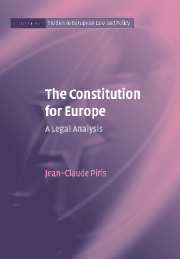Book contents
- Frontmatter
- Contents
- List of figures
- List of tables
- List of boxes
- Series editors' preface
- Acknowledgments
- Table of cases
- List of annexes
- Introduction
- 1 Is The constitution for Europe ‘dead and buried’?
- 2 The process that led to the Constitution
- 3 Changes in structures and procedures
- 4 Changes in the institutions
- 5 Changes in substance
- 6 General Assessment
- Conclusion what will the final form of the union be?
- List of annexes
- Table of equivalences between the provisions of the Treaty establishing a Constitution for Europe and the provisions of the EU and EC Treaties
- List of ‘passerelles’ and provisions on a simplified revision procedure
- Table of references
- Index
2 - The process that led to the Constitution
Published online by Cambridge University Press: 04 August 2010
- Frontmatter
- Contents
- List of figures
- List of tables
- List of boxes
- Series editors' preface
- Acknowledgments
- Table of cases
- List of annexes
- Introduction
- 1 Is The constitution for Europe ‘dead and buried’?
- 2 The process that led to the Constitution
- 3 Changes in structures and procedures
- 4 Changes in the institutions
- 5 Changes in substance
- 6 General Assessment
- Conclusion what will the final form of the union be?
- List of annexes
- Table of equivalences between the provisions of the Treaty establishing a Constitution for Europe and the provisions of the EU and EC Treaties
- List of ‘passerelles’ and provisions on a simplified revision procedure
- Table of references
- Index
Summary
The Treaty establishing a Constitution for Europe is the result of a long process.
Section 1: A short history of the idea of establishing a European Union
The idea of transforming the European Economic Community into a ‘European Union’, a single entity which would integrate all aspects of European integration, officially emerged for the first time at the 1972 Summit of the Heads of State or Government in Paris. It was then stated that ‘Member States of the Community, the driving wheels of European integration, declared their intention of converting their entire relationship into a European Union before the end of this decade’. However, the idea got lost in the turmoil of the economic crisis of the seventies, despite the recommendations made in the ‘Report on European Union’, known as the ‘Tindemans Report’, which was submitted, at their request, by the Belgian Prime Minister to the Heads of State or Government in December 1975.
Ten years later, the ‘Solemn Declaration on European Union’, signed (which is very unusual for a Declaration) at the European Council in Stuttgart in June 1983, re‐launched the idea by reaffirming the ‘will to transform the whole complex of relations between their States into a European Union’. For its part, in 1981, the European Parliament had mandated Altiero Spinelli, one of its members and a former Commissioner, together with an institutional committee, to propose amendments to the existing treaties.
- Type
- Chapter
- Information
- The Constitution for EuropeA Legal Analysis, pp. 38 - 55Publisher: Cambridge University PressPrint publication year: 2006
- 1
- Cited by

